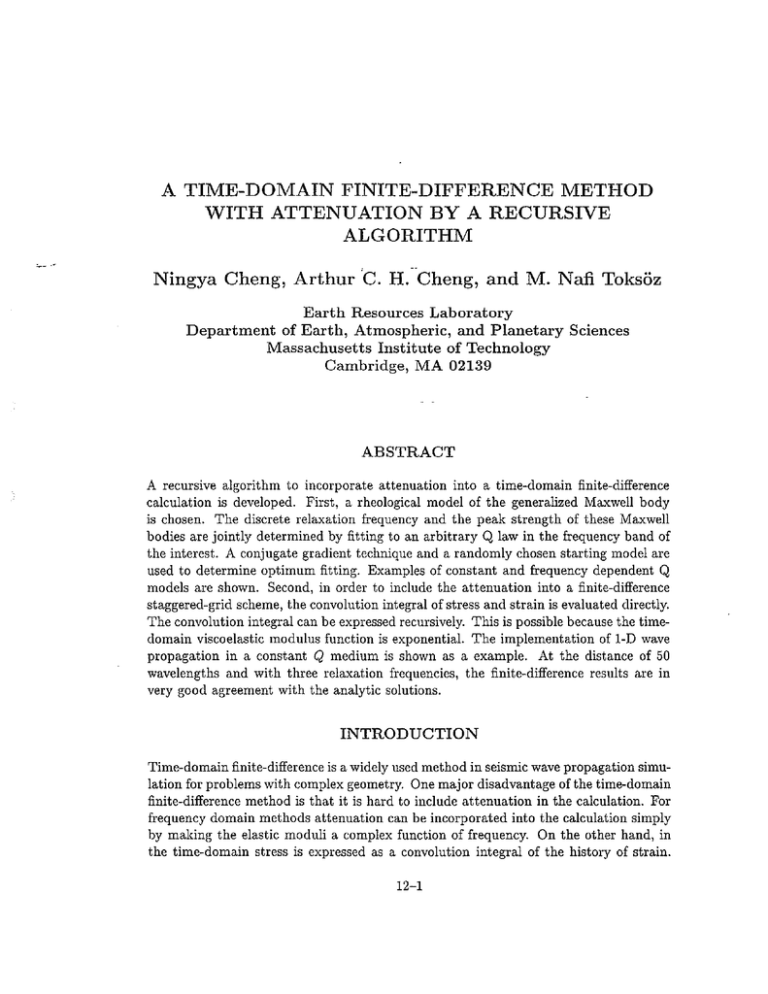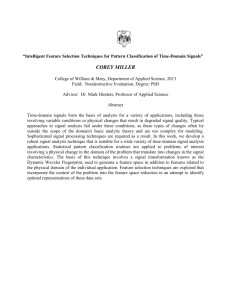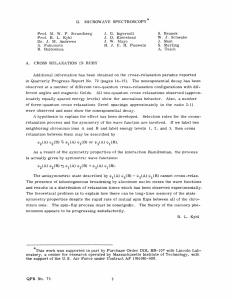A TIME-DOMAIN FINITE-DIFFERENCE METHOD WITH ATTENUATION BY A RECURSIVE ALGORITHM Ningya Cheng, Arthur
advertisement

A TIME-DOMAIN FINITE-DIFFERENCE METHOD
WITH ATTENUATION BY A RECURSIVE
ALGORITHM
Ningya Cheng, Arthur 'C. H."Cheng, and M. Nafi Toksoz
Earth Resources Laboratory
Department of Earth, Atmospheric, and Planetary Sciences
Massachusetts Institute of Technology
Cambridge, MA 02139
ABSTRACT
A recursive algorithm to incorporate attenuation into a time-domain finite-difference
calculation is developed. First, a rheological model of the generalized Maxwell body
is chosen. The discrete relaxation frequency and the peak strength of these Maxwell
bodies are jointly determined by fitting to an arbitrary Q law in the frequency band of
the interest. A conjugate gradient technique and a randomly chosen starting model are
used to determine optimum fitting. Examples of constant and frequency dependent Q
models are shown. Second, in order to include the attenuation into a finite-difference
staggered-grid scheme, the convolution integral of stress and strain is evaluated directly.
The convolution integral can be expressed recursively. This is possible because the timedomain viscoelastic modulus function is exponential. The implementation of 1-D wave
propagation in a constant Q medium is shown as a example. At the distance of 50
wavelengths and with three relaxation frequencies, the finite-difference results are in
very good agreement with the analytic solutions.
INTRODUCTION
Time-domain finite-difference is a widely used method in seismic wave propagation simulation for problems with complex geometry. One major disadvantage of the time-domain
finite-difference method is that it is hard to include attenuation in the calculation. For
frequency domain methods attenuation can be incorporated into the calculation simply
by making the elastic moduli a complex function of frequency. On the other hand, in
the time-domain stress is expressed as a convolution integral of the history of strain.
12-1
Cheng et al.
Direct evaluation of this convolution integral requires immense storage as well as the
number of operations.
Day and Minster (1984) presented a method to incorporate attenuation into timedomain calculations. Their approach is to transform the convolution integral relating
stress to strain history into a sequence of differential operators. The Pade approximation
is used in this transformation. For a frequency independent Q, the operator coefficients
can be obtained in closed form in terms of Legendre polynomials. Emmerich and Korn
(1987) improved this approach by using the rheologic.al model of the generalized Maxwell
body, which has a modulus of the desired rational form. This differential operator
approach is also used in viscoelastic finite-difference modeling (Robertsson et aI., 1994)
and the pseudospectral method (Carcione, 1993).
The purpose of this paper is to develop an algorithm to incorporate the attenuation into time-domain finite-difference calculations. We chose the rheological model of
the generalized Maxwell body. The discrete relaxation frequencies and their peaks of
strength are jointly determined by fitting a specific attenuation law. The conjugate
gradient method is used to do the optimization. We_ directly evaluate the convolution
integral by a recursive algorithm. This is possible because the time-domain viscoelastic modulus function is exponential. Finally, a 1-D finite-difference wave propagation
example is shown.
APPROXIMATION OF ATTENUATION LAW
The relationship between stress (J and strain E: in the case of linear viscoelastisity can
be expressed in the frequency domain as:
(J(W) = M(w)E:(w),
(1)
where M is the complex viscoelastic modulus. M obeys a Kramers-Kronig relation to
make the relationship between stress and strain causal. The quality factor Q is defined
as:
Q -l(W )
=
Im(M)
(2)
Re(M) ,
Here, we approximate the complex modulus M by MN, in which the relaxation spectra
consists of N single peaks of strength aj at discrete relaxation frequencies Wj. This gives
the complex modulus as:
(3)
where M,. is the unrelaxed modulus. IlM = M,. - M r , where M r is the relaxed modulus.
The complex modulus MN can also be expressed by using Mr. This allows us to
interpret the model as a sum of Maxwell bodies with viscosity ajllM/wj and elastic
12-2
Time-Domain Finite Difference Method
modulus ajb.M plus an extra elastic element M r (Emmerich and Korn, 1987). Q can
be determined by
(4)
where
Yj
=
~Z' aj'
For a given N the coefficients
Yj
and
Wj
have to be determined by
fitting to a Q law in which we are interested. Seismic data suggest that in the seismic
wave band Q-l is nearly independent of frequency. This can be characterized by a broad
relaxation spectrum (Liu et al., 1976). For a frequency independent Q, Emmerich and
Korn (1987) set the discrete relaxation frequencies Wj equidistant on a logarithmic scale
and then determined Yj by least squares fitting. Blanch et al. (1995) approximate Q by
the summation of Debye functions and solved the problem analytically by the T method,
but once again the relaxation time was pre-determined.
In this paper we determine Yj and Wj by a purely numerical method. The problem
is posed as minimization of expression:
(5)
with respect to Yj and Wj; [w a , Wb] is the frequency band we are interested in. This
method is used for this minimization purpose (Press et aI., 1992). The conjugate gradient method requires not only the value of function but also its gradient. The gradient
is computed by the finite-difference approximation. The gradient information is also
updated when the model is updated. To avoid being trapped in a local minimum, the
initial Yj is randomly chosen between zero and Q-l and Wj is randomly chosen between
W a and Wb. In the calculation there are 1000 random starting models tested and Yj and
Wj are determined from the minimum 0 of all random starting models.
As numerical examples, we consider a frequency independent Qo = 20 in the frequency range from 10-1.5 to 101.5 Hz. The comparison of Q 01 and Q-;/ are shown in
Figures 1 and 2 for the cases of N = 3 and 5, respectively. The discrete relaxation spectra are also shown on the plots. With N =5, Q"il provided a very good approximation to
the constant Q model in the frequency band. For N :':: 4, the discrete relaxation spectra
are approximately equally distanced on a logarithmic scale. Howver, when N = 5 the
spacing on logarithmic scale is no longer equal. The unevenly distributed relaxation
spectrum has a much smaller amplitude than an evenly distributed relaxation spectra
(Figure 2a).
Next, we consider a frequency dependent Q. It is given by Q = Qo..fl. This kind
of frequency dependence is due to fluid flow above a critical frequency (Toksiiz et al.,
1987). The result is plotted in Figure 3 for N = 3. The spacing on a logarithmic scale
is not uniform for discrete rela;{ation spectra distributions in the frequency dependent
Q case. Even with three relaxation spectra, the approximation is already quite good.
12-3
Cheng et al.
FINITE-DIFFERENCE METHOD WITH ATTENUATION
The wave equation in a 1-D medium is:
8v
8u
(6)
P8t=8x'
where P is the density and v is the velocity. The time-domain viscoelastic modulus MN
can be obtained by an '.nverse Fourier transform of Equation (3),
MN(t)=Mu (O(t)-
~YjWje-Wj'H(t)),
(7)
where H(t) is a unit step function. In order to use a velocity-stress formulation we need
the time derivative of the stress. Thus, we multiply by iw on both sides of equation
(1), substituting in MN(w) and doing an inverse Fourier transform to a time-domain,
we obtain:
8u
8t
(8)
(9)
and
8E:
8v
=
8t
8x·
(10)
= k6.t and assume ~~ to be constant over each time interval 6.t. We evaluate
We let t
Xj(k6.t) =
xj
xj
in a discrete manner:
8 ( )
I: l(m+llL:>t e-wj('-TLY_~dT,
k-l
=
=
m=O mL:>t
8x
eWjL:>t - 1 -kw.L:>t ~ mw·L:>t8v(m6.t)
- - - - e ' ~e '
.
Wj
m=O
8x
(11)
At first glance, it seems that computing the convolution summation (Eq. 11) requires
immense storage and a large number of operations. But since it is a summation of
exponential functions, it can be updated recursively (Luebbers et al., 1990). We derive
the formula to compute xj+l in terms of Xj. With some algebra we obtain,
X
k+l _
.
J
-
X k -w.L:>t
·e
J
'
+
(1 -
e-WjL:>') 8v(k6.t)
w·J
8x·
12-4
(12)
Time-Domain Finite Difference Method
XJ
This is the basic equation for computing xj+1 recursively with initial condition
= O.
To check its consistency with earlier work, we derive the differential equation which Xj
satisfies. With straightforward differentiation of Equation (9) we have,
oX
OE:
atj + WjXj =
at'
(13)
This is exactly equivalent to the first-order differential equation which the memory
variables satisfied [Day and Minster, 1984, Eq.(27)].
STAGGERED GRID ALGORITHM
Equations (6), (8) and (10) were used for the finite-difference calculations. Derivatives can be discretized using centered finite-difference on a staggered grid. The finitedifference scheme can be written as:
k+l/2 _
-
vi + I / 2
k-I/2
vi +1/2
6.t
k
+ p6.x (O'i+1
k
- O'i),
(14)
and
k+l
O'i
M,,6.t (k+I/2
= O'ik + ~
v i +1/2
-
k+1/2
vi _ I / 2 )
-
N
'"
k+l
M,,6.t L.. YjWjXj,i
,
(15)
J:=1
where
Xk+1
],t
=
X k .e-Wj!!.t
-w.!!.t)
+
1 - e'
(
J,'t
k+l/2 _
v i + 1/ 2
w'
J
k+I/2
vi _ I / 2
..6..x'
(16)
where i is the index for the x axis discretization.
To test our recursive algorithm, we consider a homogeneous medium with velocity
V
Vp = ~" = 2000mj s, density p = 1 gjcc and frequency-independent Q = 20. The
discretized grid size is 6.x = 100m and 6.t = 0.0458. The source signal is fed into the
stress grid and a Kelly wavelet with a center frequency of 1 Hz is used. A very simple
absorbing boundary condition is used at both ends of the grid.
The optimal discrete relaxation frequency and peak strength for attenuation are determined in the frequency bandwidth between 10- 0.5 to 10°·5 Hz. The analytic solution
in the homogeneous medium is obtained by a substitute velocity via the rule:
Vp
Wi)
1
= VI ( 1 + -Q
In(-)
- ,
1r
21r
(17)
2Q
where VI is the velocity at frequency 1 Hz. The comparisons of the finite-difference
solution and the analytic solution are plotted in Figure 4 for the distance of 50 wavelengths. The finite-difference solution with one relaxation frequency experienced a big
error. The solution drifted into the lower frequencies. With three relaxation frequencies, they provide a fairly good approximation to the constant Q. The finite-difference
waveform matches the analytic solution very well.
12-5
Cheng et al.
CONCLUSIONS
We developed a recursive algorithm to incorporate attenuation into a time-domain finitedifference method. Unlike previous studies, we directly evaluated the convolution integral of strain and stress by a recursive algorithm. This method is easy to understand
and implement and computationally efficient. In order to approximate the particular
attenuation law, the discrete relaxation frequency and strength are determined jointly
by fitting in a least-squares sense. The system is solved by the conjugate gradient
method with a randomized starting model to avoid -possible local minima. The numerical example shows very good agreement between analytic solution and the results of
finite-difference with attenuation
ACKNOWLEDGMENTS
One author (N.C.) was partially supported by Los Alamos National Laboratory as a
Posdoctoral Associate. We thank Dr. Steven Day and_ anonymous reviewers for valuable
comments on the manuscript. This work is supported by the Borehole Acoustics and
Logging and the Reservoir Delineation Consortia at MIT.
12-6
Time-Domain Finite Difference Method
REFERENCES
Blanch, J.O., Robertsson, J.O.A. and Symes, W.W., 1995, Modeling of a constant Q:
Methodology and algorithm for an efficient and optimally inexpensive viscoelastic
technique: Geophysics, 60, 176-184.
Carcione, J.M., 1993, Seismic modeling in viscoelastic media: Geophysics, 58, 1l0-l20.
Day, S.M and Minster, J.B., 1984, Numerical simulation of attenuated wavefields using
a Pade approximation method: Geophys. l.R. Astr. Soc., 78, 105-118.
Emmerich, H. and Korn, M., 1987, Incorporation of attenuation into time-domain computations of seismic wave field: Geophysics, 52, 1252-1264.
Liu, H.P., Anderson, D.L. and Kanamori, H., 1976, Velocity dispersion due to anelasticity: implications for seismology and mantle composition: Geophys. l.R. astr. Soc.,
47, 41-58.
Luebbers, R., Hunsberger, F.P., Kunz, KS., Standler, R.B. and Schneider, M., 1990, A
frequency-dependent finite difference time domain formulation for dispersive materials: IEEE Trans. Electromagn. Compat., 32, 222-227.
Press, W.H., Teukolsky, S.A., Vetterling, W~T. and Flannery, B.P., 1992, Numerical
Recipes: Cambridge University Press.
Robertsson, J.O.A., Blanch, J.O. and Symes, W.W., 1994, Viscoelastic finite-difference
modeling: Geophysics, 5g, 1444-1456.
Toksiiz, M.N., Mandai, B. and Dainty, A.M., 1990. Frequency dependent attenuation in
the crust: Geophys. Res. Let., 17, 973-976.
12-7
Cheng et al.
(a)
0.2
....
"
"
"
-
0,1-
o
,I
"
0.1
0.01
100
10
Frequency (Hz)
(b)
0.1
?!
....
0.05
,
,
,
,,
,
,
,-'
,
,,
,
,
,
o
0.01
0.1
1
10
100
Frequency (Hz)
Figure 1: Approximation of frequency independent Q-l with discrete relaxation spectra
with N=3. (a) Discrete relaxation frequency and its peak strength. (b) Solid line
for exact Q-l and dashed line for approximated Q-l.
12-8
Time-Domain Finite Difference Method
(a)
,
.,
0.1
>0
--
0.05
o
0.01
I
'I
0.1
"
"
100
10
Frequency (Hz)
(b)
0.1
e'
....
,
0.05
,
,
o
0.01
0.1
10
100
Frequency (Hz)
Figure 2: Approximation of frequency independent Q-l with discrete relaxation spectra
with N=5. (a) Discrete relaxation frequency and its peak strength. (b)Solid line for
exact Q-l and dashed line for approximated Q-l.
12-9
Cheng et al.
0.4
0.3
....
0.2
-
-
0.1
f-
-
0
0.01
'r
'I
0.1
1
I
'I
100
1 0
Freqnency (Hz)
(b)
0.1
CI
-.
....
0.01
,,
,,
0.001
0.01
0.1
1
1 0
100
Frequency (Hz)
Figure 3: Approximation of frequency dependent Q-l with discrete relaxation spectra
with N=3. (a) Discrete relaxation frequency and its peak strength. (b) Solid line
for exact Q-l and dashed line for approximated Q-l.
12-10
Time-Domain Finite Difference Method
N=l
0.015
,
,"'
,,
,,
,
,
,
o
,
,
,
-0.015
o
2
4
6
8
6
8
6
8
T·XN (sec)
N=2
0.015
~
- -
~
-
o
-- -
,
-0.015
o
2
4
T·XN (sec)
N=3
0.015
~--
o
--
,,
-0.015
o
2
4
T·X/V (sec)
Figure 4: Comparison of analytic solution with finite difference result at distance 50
wavelength for Q=20. Discrete relaxation spectra N = 1,2,3 are considered.
12-11
Cheng et al.
12-12




